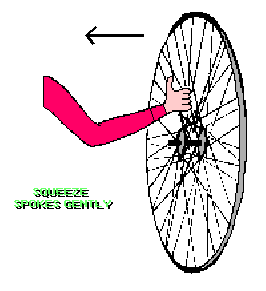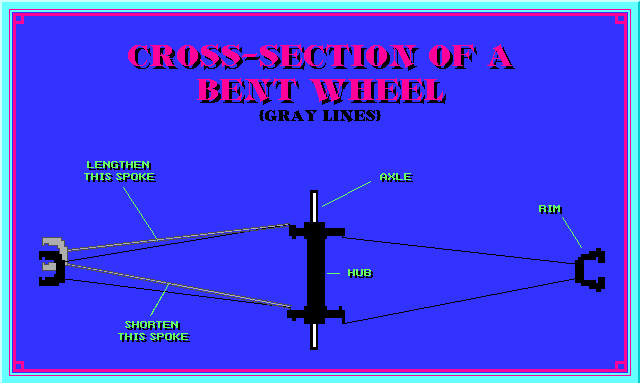"Save Big With Bicycle Discount Coupon Codes"
Bicycle Tune-Up Step 5 - Bicycling Wheel Truing I
For Building Bicycle Wheels (Lacing Spokes)
Straightening a bike wheel is more of an art than a science, but it is a skill anyone can learn with enough practice.
The most common wheel problem is a lateral or sideways bend. For a bike wheel laterally out of true, this is what you do:
Leave the wheel on the bike and the tire and tube inflated. Hang the bike up. Turn the wheel around until you find the area which is the most bent. Use the brake pads (perhaps adjusted closer) or a pencil held next to the bike frame to indicate clearly the location of the bend.
If you were to shorten some of the spokes going from the bent area to the side of the hub opposite the direction of the bend, or lengthen the spokes on the side toward which it is bent, the rim would bend back toward the center.
And this is exactly what you do. First, experiment with the effect. Grab a handful of spokes about half-way between the hub and the rim at the brake caliper. Squeeze, which will momentarily bend the spokes, effectively shortening them. You will see the wheel rim move toward the side of the brake.

By turning a spoke nipple clockwise as seen from the top (pretend you can see through the tire and tube), you are shortening the spoke properly.
Generally you work with a group of about four or five spokes at the site of the bend, shortening a few and lengthening some others. Turn the spoke nipples just a half turn or so each, and check the effect. You should loosen some and tighten others because if you were to tighten only, you would create a flat spot in an otherwise round wheel.
If the bike wheel is quite bent, you may need to work with a larger group, to share the load of pulling the wheel true.
After the wheel is nearly true, tighten whatever spokes are too loose, then finish aligning the wheel.
It is not possible to describe the correct spoke tension. It is something you have to experience for yourself. To know how much to tighten spokes, check several bike wheels using two techniques. Squeeze a handful of spokes at the intersections to see how much they deflect, and turn a few random spokes in various wheels with a spoke wrench. Turn the spokes a half-turn looser, then retighten them the same amount, to get a feel for the correct tightness.
Wheels that require extensive work, or ones that may have an unreliable rim strip should have the tire and tube removed before adjusting spoke lengths to prevent puncturing the inner tube.
If any spokes protrude beyond the tops of the spoke nipples, you will need to file off the excess length.
![]()
Unbending A Bicycle Bent Wheel
Wheels that are severely bent cannot be repaired easily. You cannot have the spokes pulling hard against a rim that is very bent. This would cause a weak wheel that may bend again, or perhaps some spokes may break eventually.
In the case of severely bent rims you must unbend the wheel before adjusting the spokes. Standing on the wheel, or leaning on it against a table will do the trick. Some people will hit it with a big rubber mallet. However you do it, be sure you are operating on the exact area where the bend is. If you accidentally add another bend, instead of fixing the first one, the repair will be much more difficult.
Severely bent aluminum (also known as "alloy") rims are more difficult to straighten than steel rims because they are springier and more brittle at the same time. If you have done major work on an aluminum rim, check it carefully for visible cracks. If you find a crack, the rim should not be used.
Unbending a wheel is a skill that requires lots of practice to be a reliable repair technique. Good luck!

Continue To Wheel Straightening II
3 Things You Need To KnowBefore You Buy
![]()
Back - Rear Hub Bearings & Freewheel
Tell a Friend About BikeWebSite
Please feel free to link your web pages to www.bikewebsite.com.
![]()
Copyright © 1991-2014, bikewebsite.com